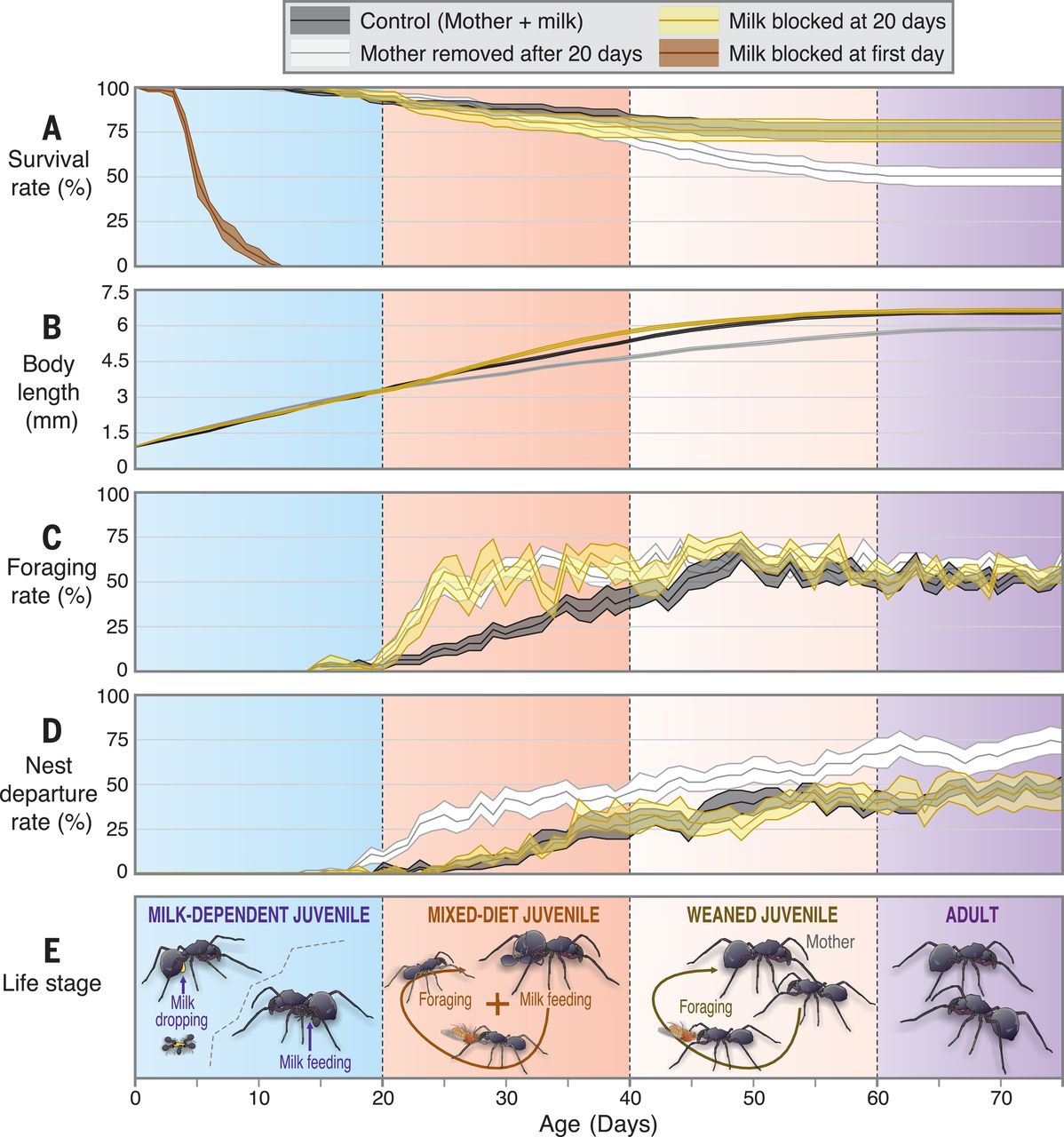博文
科学新发现:“喂奶”的蜘蛛!
 精选
精选
|
科学新发现:蜘蛛也能喂奶!哺乳历来都被认为是哺乳动物独有的行为,中国科学院西双版纳热带植物园研究人员发现了一种跳蛛(大蚁蛛)具有长期的“哺乳行为”,且这种哺乳行为和行为模式上、持续时间上还是功能上都与真正哺乳动物极其一致,这是国际上发现首例哺乳动物之外能通过哺乳养育后代的现象。该研究成果于11月30日在线发表在《Science》杂志上,论文标题为Prolonged milk provisioning in a jumping spider(http://science.sciencemag.org/content/362/6418/1052.full)。由于具备重要的原创性意义和科学传播价值,该项研究还被《科学》杂志news报道。

本文作者发现了一些很有趣的现象,一是蜘蛛乳汁的蛋白质含量高的出乎意料,达到了牛奶的4倍左右;同时,大蚁蛛还可以像高等哺乳动物一样对幼蛛进行哺乳。研究者发现这些乳汁是从雌性蜘蛛的生殖沟分泌出来的,新孵化出来的幼蛛在前20天之完全依赖吸食乳汁而生长;从20天到40天为幼蛛“断奶”前的过渡期,幼蛛除了继续从母体吸食乳汁外,也会自己外出捕猎获取食物,40天时幼蛛完全断奶;断奶后的幼蛛并不会离开其母亲,而会继续回巢生活;成年之后的雌性后代也继续和母亲生活在同一巢穴,但雄性后代责备赶出家庭。



大蚁蛛是独立于哺乳动物系统进化而来的,该发现可帮助科学家更好地了解亲代对后代长期乳汁喂养的进化。动物生态学家Nick Royle认为,大蚁蛛的长期哺乳行为研究成果令人振奋,在整个动物界,除哺乳动物以外,亲代为后代提供来自亲代体内物质的现象非常罕见,该研究在大蚁蛛中发现了亲代长期抚育后代的证据,以及在无脊椎动物中发现了迄今为止最全面的超长亲代抚育的证据(文字资料参考中科院新闻网,图片来自论文原文)。
Science News 原文如下:
Spider moms spotted nursing their offspring with milk
On a summer night in 2017, Chen Zhanqi made a curious find in his lab in China’s Yunnan province. In an artificial nest, he spotted a juvenile jumping spider attached to its mother in a way that reminded him of a baby mammal sucking its mother’s teats. On closer inspection, the spider mom really seemed to be doting on her young, he says. “She had to invest so much in caring for the baby.”
Further study by Chen and Quan Rui-Chang, behavioral ecologists at the Chinese Academy of Sciences’s Center for Integrative Conservation in Menglunzhen, confirmed the jumping spider females were indeed producing milk for their offspring—and that they continued to do so even after the spiderlings became teenagers, they and colleagues report today.
Providing milk and long-term care together is virtually unheard of in insects and other invertebrates. And with the exception of mammals, it’s not even that common among vertebrates. As such, the results “help increase our understanding of the evolutionary origins of complex forms of parental care,” says Nick Royle, a behavioral ecologist at the University of Exeter in the United Kingdom who was not involved with the work. They suggest prolonged mothering may not require the complex brain power that researchers have assumed, he says.
Females of this jumping spider species (Toxeus magnus) lay between two and 36 eggs at a time. As soon as the eggs hatch, the mother begins to deposit tiny milky droplets around the nest, Chen and colleagues observed in the lab. When the team members analyzed the liquid, they discovered it contained four times the protein of cow’s milk, as well as fat and sugar.
In their first couple of days, the baby spiders sipped droplets of this spider milk around the nest, the researchers observed. But soon they began to line up at the entrance of the mother’s birth canal to suckle. At 20 days, they began to hunt outside the nest, but they still supplemented their diet with mother’s milk until they were sexually mature—another 20 days.
When Chen painted over the mothers’ birth canals to cut off the milk supply, spiders younger than 20 days all died. When he removed the mother from the nest, older spiders grew more slowly, left the nest sooner, and were more likely to die before adulthood, he and his colleagues report today in Science. Other spiders may hang around their young for a few days but rarely feed them.
The “milk” may be liquified eggs that are passed out of the birth canal prematurely, Quan says. Some amphibians and other invertebrates lay similar “trophic eggs” for offspring to eat, he notes, although only when those offspring are really young. Cockroaches also produce “milk,” but that nourishment is simply absorbed passively through the eggshell of their embryos and is not part of the hatched roachlings’ diets.
The long-lasting parental care the team observed in jumping spiders mostly exists only in very few long-lived social vertebrates, such as humans and elephants, Quan says. “The extended maternal care indicates that invertebrates have also evolved [this] ability.”
Rosemary Gillespie, an evolutionary ecologist at the University of California, Berkeley, notes some other spider species also seem to provide for their young. One study in the 1990s observed that spiderlings of the funnel web spider Coelotes ate clear yellow drops of liquid or brownish clusters deposited on the web. Mothers of another spider called Amaurobius lay “naked” egg sacs that spiderlings immediately devour.
Such care often signals a greater than usual offspring need, Royle says. For example, if there’s a chance there will be no food for newborns, or that young spiders are likely to be eaten by other predators before they have a chance to grow up and reproduce, then it can make sense for a mother to become a “helicopter” parent, he explains. Because this behavior taxes the mother, he adds, it likely only evolves in extreme situations.
https://blog.sciencenet.cn/blog-3319332-1149213.html
上一篇:冬荷神韵!
下一篇:20181201——长穗花